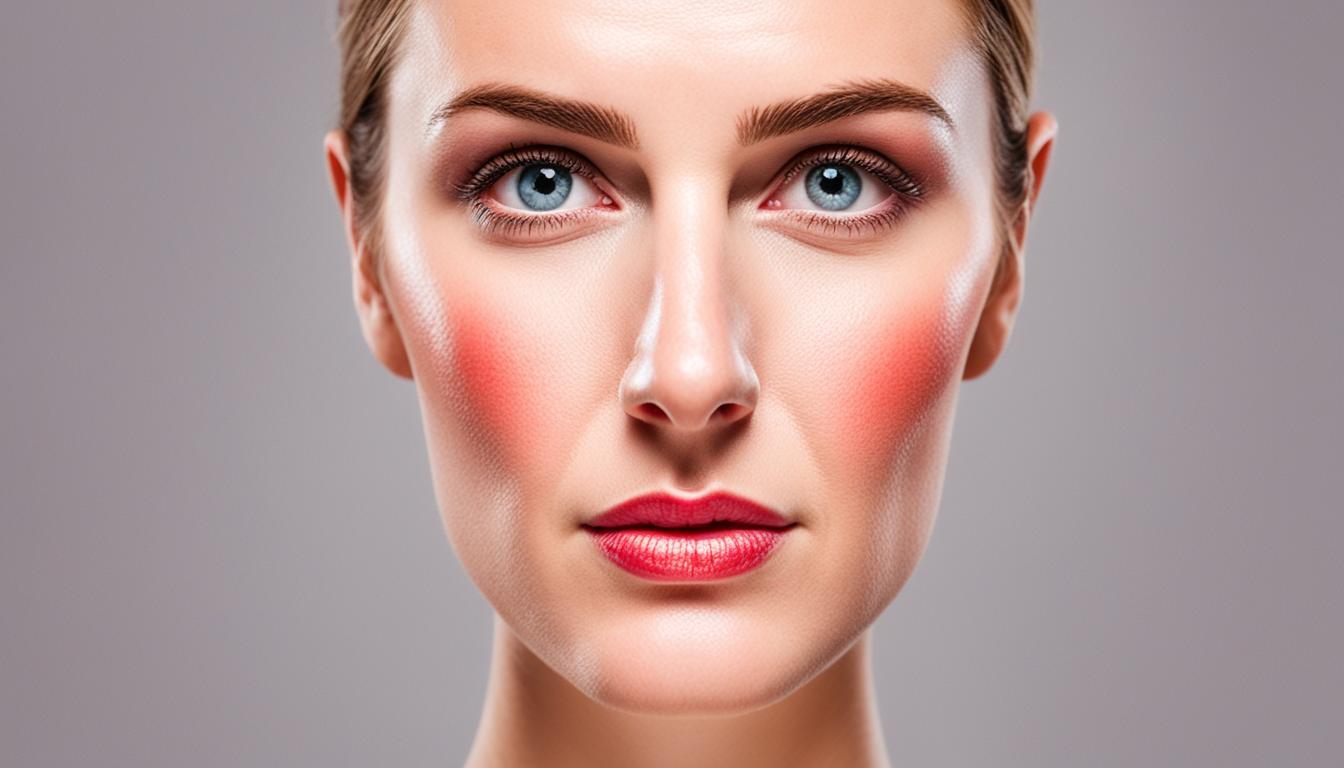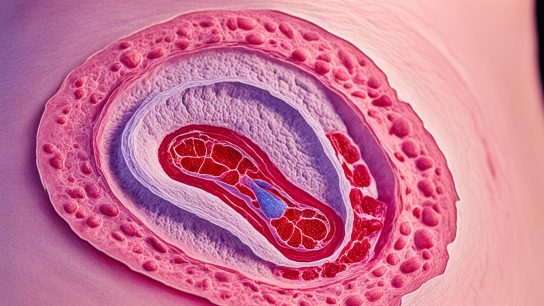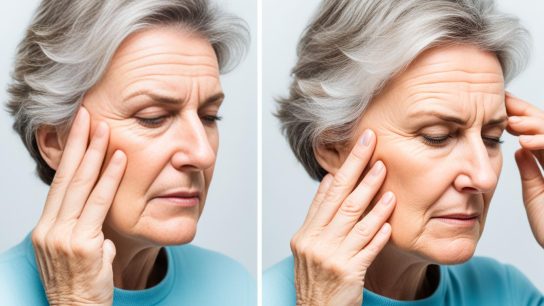Did you know that feeling hot in the face without the rest of the body experiencing the same sensation is a common phenomenon? It can be puzzling and leave you wondering why this happens. There are several potential factors that contribute to this occurrence, ranging from environmental and lifestyle factors to medical conditions and hormonal changes.
While fever typically causes the entire body to feel hot, there are instances where only the face feels hot without a fever. This facial heat sensation can be attributed to various reasons, including heat-related illnesses, exercise, spicy foods, anxiety, hyperthyroidism, anhidrosis, diabetes, pregnancy, and menopause.
Understanding why your face feels hot but not the rest of your body is essential for determining the appropriate treatment or management strategies. In this article, we will delve deeper into the causes, mechanisms, and tips for managing facial flushing and heat sensation.
What is Facial Flushing?
Facial flushing is the term used to describe the redness and heat sensation in the face that occurs when the blood vessels just beneath the skin dilate and fill with more blood. This can result in a noticeable change in skin color, ranging from pink to deep red. The dilation of blood vessels is often a physiological response to various stimuli, such as emotional triggers, heat exposure, exercise, and certain medical conditions.
Facial flushing is a complex process involving the regulation of facial blood flow, skin temperature, vasodilation, and sensitivity. Understanding the mechanisms behind facial flushing can help in identifying the underlying causes and appropriate management strategies.
Factors contributing to facial flushing:
- Emotional triggers
- Heat exposure
- Exercise
- Medical conditions
When the blood vessels in the face dilate, it increases blood flow to the area, leading to a rise in facial skin temperature. This dilation, known as facial vasodilation, can be triggered by various factors, including the release of neuropeptides, such as substance P, and the activation of the sympathetic nervous system.
Facial flushing can also be influenced by individual differences in facial temperature regulation and skin sensitivity. Some people may be more prone to facial flushing due to genetic factors or underlying conditions that affect the body’s ability to regulate temperature.
Overall, understanding facial flushing and its underlying processes can help individuals identify triggers, manage symptoms, and seek appropriate medical attention when necessary.
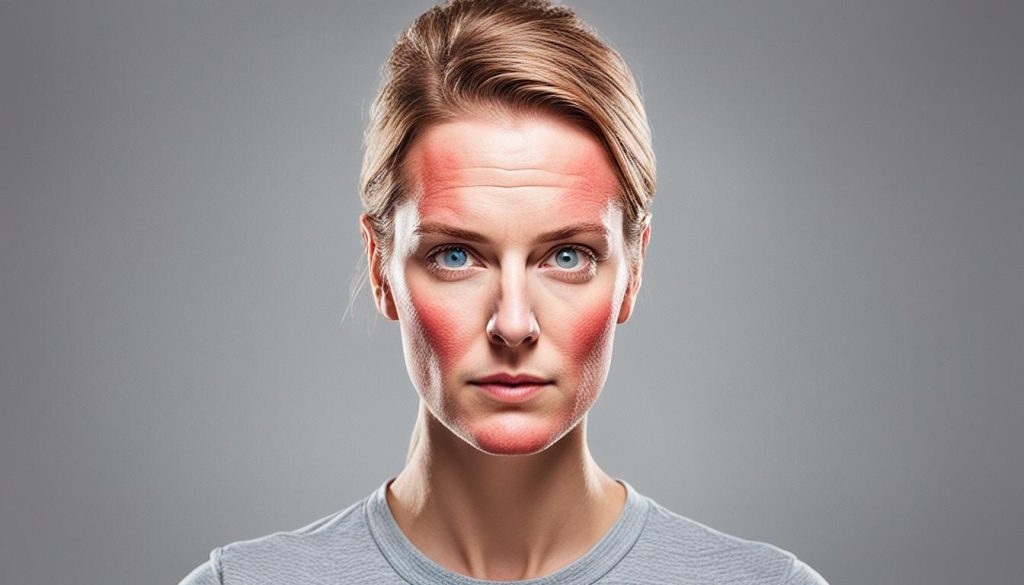
In the next section, we will explore the possible causes of a hot face and discuss how different factors contribute to facial flushing.
Possible Causes of a Hot Face
A hot face can be a perplexing sensation, especially when it occurs without an increase in overall body temperature. There are several potential causes for this phenomenon:
| Possible Causes | Description |
|---|---|
| Heat-related illnesses | Conditions like sunburn and heat exhaustion can cause the face to feel hot while the body remains relatively unaffected. |
| Exercise or strenuous activity | Physical exertion can lead to increased blood flow and circulation to the face, resulting in a sensation of heat. |
| Consumption of certain foods and drinks | Alcohol and spicy foods, in particular, can cause facial flushing and a hot sensation in the face. |
| Tight or dark clothing | Wearing clothing that restricts airflow or absorbs heat can contribute to facial heat sensation. |
| Anxiety and stress | Emotional states can trigger a sympathetic response, leading to increased blood flow to the face and a feeling of heat. |
| Underlying medical conditions | Certain conditions like hyperthyroidism, anhidrosis, diabetes, pregnancy, menstrual cycles, and menopause can disrupt facial temperature regulation and result in a hot face sensation. |
| Individual differences in skin sensitivity | Some individuals may naturally have more sensitive skin or irregular facial temperature regulation, resulting in a hot face sensation without an apparent cause. |

Why Does My Face Feel Hot but Not the Rest of My Body?
The sensation of a hot face without feeling hot in the rest of the body can be attributed to various factors. Environmental and lifestyle factors, such as hot weather, exercise, and clothing choices, can affect body heat distribution and contribute to a hot face. Additionally, medical conditions like anxiety, hyperthyroidism, anhidrosis, diabetes, and hormonal changes during pregnancy and menopause can impact facial temperature regulation and blood flow, resulting in a hot face sensation. It is important to consider these factors and seek medical attention if the hot face sensation is persistent, severe, or accompanied by other concerning symptoms.
1. Factors Affecting Facial Heat Sensation
Multiple factors can contribute to the sensation of a hot face while the rest of the body remains unaffected. These factors can be classified into two categories: environmental and lifestyle factors, and medical conditions.
2. Environmental and Lifestyle Factors
Environmental and lifestyle factors can have a significant impact on body heat distribution and contribute to a hot face sensation. When exposed to hot weather or engaged in physical activities that increase body temperature, it is natural for the face to feel hot due to increased blood flow to the area. Additionally, wearing tight or dark clothing that restricts airflow can trap heat and contribute to facial heat sensation.
3. Medical Conditions
Various medical conditions can disrupt facial temperature regulation and result in a hot face sensation. Anxiety and stress can cause blood vessels in the face to dilate, leading to facial flushing and heat. Hyperthyroidism, a condition characterized by an overactive thyroid gland, can increase metabolism and body heat production, contributing to a hot face. Anhidrosis, the inability to sweat properly, can disrupt the body’s cooling mechanisms and cause heat to accumulate in the face. Diabetes, pregnancy, and menopause can also affect hormonal balance and blood flow, resulting in a hot face sensation.
In some cases, the hot face sensation may not have an apparent cause or may be due to individual differences in skin sensitivity or facial temperature regulation. If the hot face sensation persists, is severe, or is accompanied by other concerning symptoms, it is important to consult a healthcare professional for a proper evaluation and appropriate treatment.
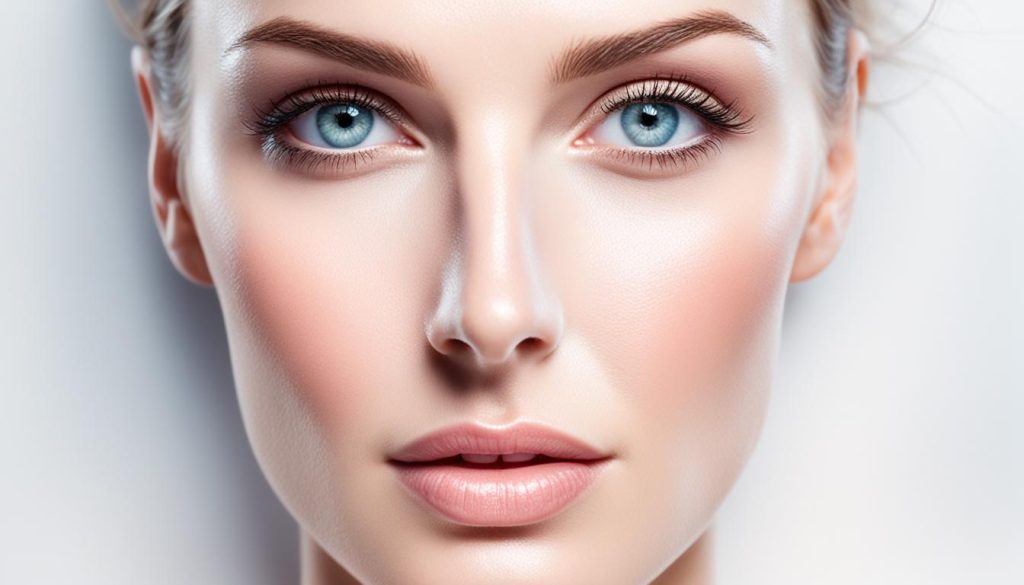
Medical Conditions Associated With Facial Flushing
Facial flushing can be a symptom of various medical conditions. Understanding these conditions can help identify the underlying cause of facial flushing and guide appropriate diagnosis and treatment. Some of the medical conditions associated with facial flushing include:
1. Rosacea
Rosacea is a chronic skin condition characterized by facial redness and the presence of small bumps or pustules. It primarily affects the central portion of the face, including the cheeks, nose, forehead, and chin. Facial flushing is a common symptom of rosacea, often triggered by factors such as alcohol, spicy foods, temperature changes, and emotional stress. Proper management of rosacea involves lifestyle modifications, topical medications, and in some cases, oral medications prescribed by a dermatologist.
2. Alcohol Flush Reaction
Alcohol flush reaction, also known as Asian flush or Asian glow, is a condition that affects some individuals of East Asian descent. It is characterized by a facial flushing reaction after consuming alcohol. The flushing is caused by an inherited deficiency in the enzyme responsible for metabolizing alcohol, leading to the accumulation of a toxic metabolite called acetaldehyde. Individuals with alcohol flush reaction may experience other symptoms such as nausea, rapid heartbeat, and headache. Although there is no cure for this condition, avoiding or limiting alcohol consumption can help manage the flushing reaction.
3. Thyroid Disease
Thyroid disease, particularly hyperthyroidism, can impact hormone production and lead to facial flushing. Hyperthyroidism is characterized by an overactive thyroid gland, which can cause increased blood flow to the face and dilation of blood vessels. This can result in facial redness and heat sensation. Thyroid disease requires proper medical evaluation, diagnosis, and management by an endocrinologist.
4. Carcinoid Syndrome
Carcinoid syndrome is a rare condition caused by certain types of tumors that release substances such as serotonin. Facial flushing is one of the hallmark symptoms of carcinoid syndrome. In addition to flushing, individuals with carcinoid syndrome may experience diarrhea, abdominal pain, wheezing, and other systemic symptoms. Proper diagnosis and treatment of carcinoid syndrome are essential and typically involve a multidisciplinary approach with medical oncologists, surgeons, and other specialists.
These are just a few examples of medical conditions that can cause facial flushing. It is important to consult a healthcare professional for proper diagnosis and treatment if you experience persistent or concerning facial flushing, especially if it is accompanied by other symptoms.
| Medical Condition | Symptoms | Treatment |
|---|---|---|
| Rosacea | Facial redness, small bumps or pustules | Lifestyle modifications, topical medications, oral medications prescribed by a dermatologist |
| Alcohol Flush Reaction | Facial flushing, nausea, rapid heartbeat, headache | Avoiding or limiting alcohol consumption |
| Thyroid Disease | Facial flushing, increased blood flow to the face | Proper evaluation, diagnosis, and management by an endocrinologist |
| Carcinoid Syndrome | Facial flushing, diarrhea, abdominal pain, wheezing | Multi-disciplinary approach with medical oncologists, surgeons, and other specialists |
Tips for Managing Facial Flushing
Facial flushing can be a frustrating and uncomfortable experience. While it may not always be possible to completely eliminate facial flushing, there are several strategies that can help manage and reduce the sensation. Incorporating these tips into your daily routine can provide relief and improve your overall well-being.
1. Lifestyle Strategies
1. Choose lightweight, breathable clothing: Opt for loose-fitting garments made from natural fibers, such as cotton or linen. These materials allow better air circulation and can help prevent excessive heat buildup on the skin.
2. Avoid triggers: Identify and avoid triggers that may cause or exacerbate facial flushing. Common triggers include spicy foods, caffeine, alcohol, and hot beverages. Keeping a food diary can help you pinpoint specific triggers and adjust your diet accordingly.
3. Maintain a comfortable environment: When the weather is hot, seek out air-conditioned spaces to cool down and reduce facial heat. If you don’t have access to air conditioning, use fans or open windows to promote air circulation.
2. Home Remedies
1. Cool showers and compresses: Taking cool showers or applying cool compresses directly to the face can help soothe and reduce facial heat. The cold temperature helps constrict blood vessels and alleviate redness.
2. Relaxation techniques: Stress and anxiety can contribute to facial flushing. Engaging in relaxation techniques, such as deep breathing exercises, meditation, or yoga, can help reduce tension and promote overall calmness.
3. Medical Interventions
1. Prescription medications: In some cases, a healthcare professional may prescribe medications to manage facial flushing. These may include beta-blockers, alpha-agonists, or anticholinergic drugs. It is important to follow your healthcare provider’s instructions and discuss any concerns or side effects.
2. Medical procedures: Certain medical procedures, such as laser treatments or intense pulsed light therapy, may be recommended to reduce facial redness and improve overall skin tone. These procedures should always be performed by qualified professionals.
Remember, everyone’s experience with facial flushing is unique. It’s important to identify your personal triggers and develop a management plan that suits your individual needs. If facial flushing persists or is accompanied by other concerning symptoms, it’s always a good idea to seek medical advice for proper diagnosis and treatment options.
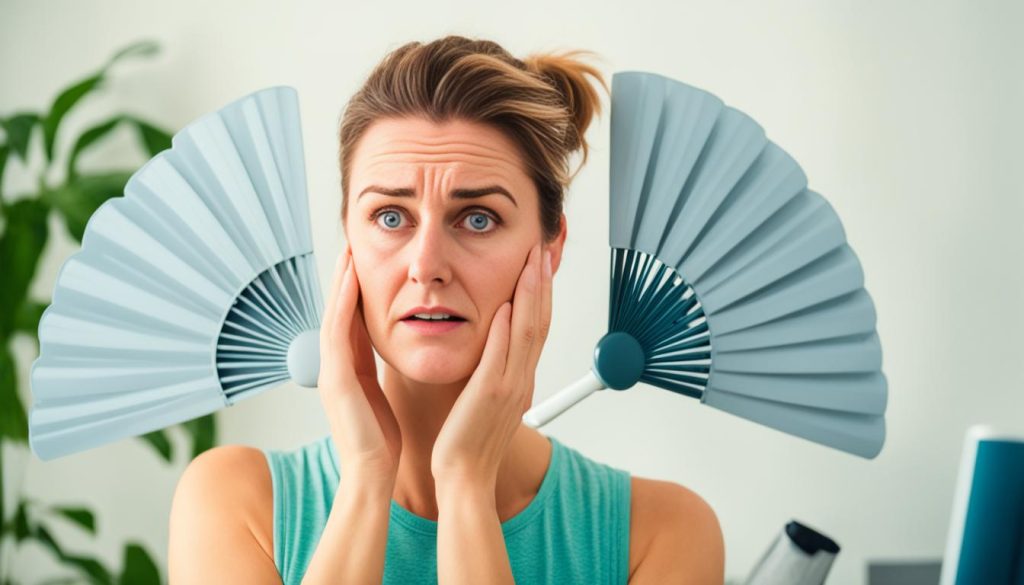
| Strategies | Benefits |
|---|---|
| Choose lightweight clothing | Improves air circulation and reduces heat buildup |
| Avoid triggers | Prevents facial flushing episodes by eliminating specific triggers |
| Maintain a comfortable environment | Reduces external factors that contribute to facial heat |
| Cool showers and compresses | Soothes and constricts blood vessels to alleviate facial redness |
| Relaxation techniques | Reduces stress and anxiety, which can trigger facial flushing |
| Prescription medications | Medical intervention to manage and control facial flushing |
| Medical procedures | Advanced treatments to improve skin tone and reduce redness |
When to Seek Medical Attention for Facial Flushing?
Facial flushing is a common phenomenon that is usually harmless and temporary. However, there are certain situations where seeking medical attention is crucial to ensure your well-being. If you experience severe or frequent facial flushing episodes accompanied by other concerning symptoms such as difficulty breathing, chest pain, rapid heart rate, or fainting, it is important to consult a healthcare professional as soon as possible.
In addition to the aforementioned symptoms, if you notice persistent facial flushing accompanied by unexplained weight loss, fatigue, or changes in bowel habits, it is important to seek medical evaluation to rule out any underlying medical conditions that could be causing these symptoms.
By seeking medical attention, a healthcare professional can provide you with a proper diagnosis and recommend appropriate treatment options tailored to your specific needs. Remember, it is always better to be safe than sorry when it comes to your health.
| When to seek medical attention for facial flushing? | Reasons for seeking medical attention |
|---|---|
| If facial flushing is severe, frequent, or accompanied by other concerning symptoms | Difficulty breathing, chest pain, rapid heart rate, or fainting |
| If facial flushing is associated with other persistent symptoms | Unexplained weight loss, fatigue, or changes in bowel habits |
Lifestyle Factors That Contribute to Facial Flushing
Facial flushing, characterized by facial redness and a sensation of heat, can be influenced by various lifestyle factors. By recognizing and addressing these factors, it is possible to manage and reduce the occurrence of facial flushing episodes. Some key lifestyle factors to consider include:
1. Extreme Temperatures and Weather Conditions
Exposure to hot weather, high humidity, or extreme cold temperatures can trigger facial flushing. When faced with such conditions, your body may respond by dilating blood vessels, leading to facial redness and a feeling of heat on the face. To minimize the impact of weather-related flushing, ensure proper hydration, wear protective clothing and accessories, and seek shade or air-conditioned environments when necessary.
2. Excessive Consumption of Alcohol or Spicy Foods
Alcohol and spicy foods are known triggers for facial flushing in many individuals. Alcohol can cause blood vessels in the face to dilate, while spicy foods can stimulate nerve receptors and increase blood flow to the skin. To mitigate the effect of these triggers, it is advisable to moderate alcohol consumption and avoid spicy foods if they consistently lead to facial flushing.
3. Clothing Choices
Wearing tight or dark clothing that restricts airflow can exacerbate facial flushing. When clothing doesn’t allow proper ventilation, it can cause heat to accumulate in the body and trigger flushing on the face. Opt for loose-fitting and breathable fabrics that allow air circulation to help regulate body temperature and reduce the occurrence of facial flushing.
4. Stressful or Anxiety-Inducing Situations
Mental and emotional stress can contribute to facial flushing. Stress activates the body’s sympathetic nervous system, leading to increased blood flow and dilation of blood vessels. Find effective stress management techniques that work for you, such as practicing mindfulness, deep breathing exercises, or engaging in activities that promote relaxation. By reducing stress, you may also reduce the frequency and intensity of facial flushing.
By understanding and addressing these lifestyle factors, individuals experiencing facial redness, heat on the face, or face feeling hot for no reason can take proactive steps towards managing and reducing facial flushing. Making conscious choices regarding clothing, diet, stress management, and environment can positively impact facial flushing symptoms.
How to Manage and Reduce Facial Flushing?
In order to effectively manage and reduce facial flushing, it is crucial to address the underlying causes and triggers. A comprehensive approach that combines lifestyle changes and, if necessary, medical interventions can help minimize the frequency and severity of facial flushing episodes.
First and foremost, implementing certain lifestyle changes can make a significant difference. Dressing in lightweight and breathable clothing can help regulate body temperature and prevent excessive sweating, which can trigger facial flushing. Avoiding common triggers like spicy foods and alcohol, which have been known to stimulate blood vessels and increase facial redness, is also advised.
Stress and anxiety can also contribute to facial flushing episodes. Practicing relaxation techniques, such as deep breathing, meditation, or yoga, can effectively manage stress and potentially reduce the occurrence of facial flushing. Additionally, maintaining a healthy lifestyle with regular exercise and a balanced diet can help regulate blood flow and promote overall well-being.
While lifestyle changes can be effective, some cases of facial flushing may require medical interventions. If facial flushing is persistent, severe, or accompanied by other concerning symptoms, it is important to consult with a healthcare professional for proper diagnosis and treatment options. They may prescribe medications or recommend specialized treatments to address the underlying causes of facial flushing.
By understanding personal triggers and developing a personalized management plan that combines lifestyle changes and potential medical interventions, individuals can effectively manage and reduce facial flushing, leading to a better quality of life and increased confidence.
Conclusion
When experiencing a flushed face without a fever, it is essential to identify and address the underlying causes. Managing stress through stress management techniques, such as deep breathing exercises or meditation, can help reduce facial flushing. Additionally, avoiding temperature extremes and identifying triggers like spicy foods and alcohol can also play a role in minimizing facial flushing episodes.
Using gentle skincare products can be beneficial as harsh products may exacerbate the symptoms. If the flushed face persists or interferes with daily life, seeking medical care and evaluation is recommended. A healthcare professional can perform a thorough physical examination, review your medical history, and conduct additional tests to determine the underlying cause of your facial flushing. Treatment options can then be tailored to address your specific condition.
Remember, our face is often the first thing people notice about us, and it’s important to feel comfortable and confident in our own skin. By understanding the causes of facial flushing and taking proactive steps to manage them, you can regain control and live your life with a radiant and healthy complexion.
FAQ
1. What environmental and lifestyle factors can contribute to feeling hot without a fever?
Hot weather, extreme temperatures, and prolonged sun exposure can cause conditions like sunburn, heat exhaustion, and heatstroke, leading to facial flushing. Exercising or engaging in physical tasks, especially in hot or humid environments, can also raise body heat and cause facial flushing. Consuming certain foods and drinks such as spicy food, alcohol, and caffeine can trigger a feeling of heat in the face. Wearing tight or synthetic clothing can restrict air circulation and trap heat, leading to increased warmth and sweating.
2. Can emotional states and anxiety cause facial flushing?
Yes, strong emotions like embarrassment, excitement, anger, or stress can trigger a feeling of heat in the face, known as blushing. This is a result of the fight-or-flight response, which releases adrenaline and causes blood vessels to dilate. In addition to facial flushing, anxiety and stress can also cause physical symptoms such as increased heart rate, heart palpitations, tense muscles, and rapid breathing. Managing stress and anxiety through relaxation techniques and therapy can help reduce these symptoms.
3. Are there any medical conditions that can contribute to facial flushing?
Yes, certain medical conditions can contribute to facial flushing. Hyperthyroidism, an overactive thyroid gland, can cause heat intolerance and facial flushing, along with symptoms like shaky hands, rapid heartbeat, diarrhea, difficulty sleeping, and fatigue. Anhidrosis, the inability to sweat, can also lead to facial flushing. Diabetes can make individuals more sensitive to heat due to dehydration and complications that affect sweat glands. Hormonal factors, such as menopause and pregnancy, can also cause hot flashes and facial flushing. Hormone replacement therapy can help manage these symptoms in menopause.
4. Can medications cause facial flushing?
Yes, some medications can cause facial flushing as a side effect. This includes blood pressure medicines, erectile dysfunction drugs, niacin, chemotherapy drugs, antibiotics, and certain topical medications. Allergic reactions, such as contact dermatitis, can also lead to redness, warmth, and itching in the face. It is important to be aware of the potential side effects of medications and seek medical advice if facial flushing occurs after starting a new medication. Avoiding triggers and using mild skincare products can help manage allergic reactions.
5. How can I address and manage feeling hot in the face without a fever?
Feeling hot in the face without a fever can have various causes, and it is important to identify and address the underlying factors. Managing stress, avoiding temperature extremes, and identifying triggers such as spicy foods and alcohol can help reduce facial flushing. Using gentle skincare products and seeking medical evaluation if the symptoms persist or interfere with daily life is recommended. A healthcare professional can perform a physical examination, review medical history, and conduct additional tests to diagnose the cause of facial flushing and provide appropriate treatment options.

